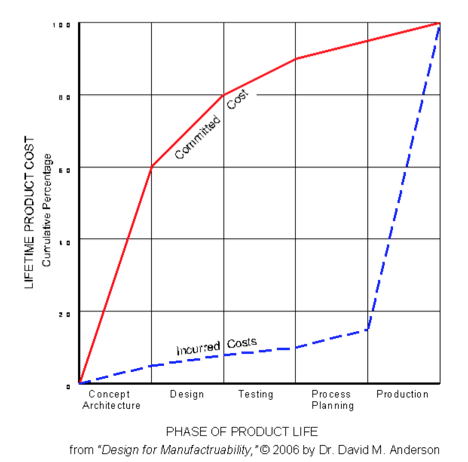Time to read: 4 min
Designing parts for efficient product assembly is a primary hardware development consideration. Even if labor costs are a relatively small percentage of the final selling price, problems in assembly can generate tremendous costs, incur production delays, and result in suboptimal part quality.
Since the largest financial impact in hardware development comes during the production phase of a product lifecycle, planning for manufacturing and assembly early on can help manage overall product costs.
Typically, 80% of future committed costs can be calculated before completing the design stage, where incurred costs are still below 10%. Knowing this, the best place to identify cost reductions is in the prototyping phase and not during production.

This is where the principles of Design for Assembly (DFA) come into play.
The basic idea behind DFA is simple: Design products that can be assembled from start to finish, with the least amount of effort and for the lowest price.
Here are some of the key considerations to keep in mind as you design products in preparation for production assembly.
Remove Unnecessary Steps
The most effective way to reduce the amount of effort that goes into assembly is to directly remove steps in the assembly process. The less a human has to do, the quicker and less complex an assembly becomes. The two best ways to do so are:
1. Reduce the Number of Components
This applies to both the total number of components as well as the number of unique components in your system. In general, you should determine the theoretical minimum number of parts and stay as close to that number as possible. Identify your theoretical minimum by asking:
- Does a given part absolutely need to be a different material?
- Must the part be separated to allow for disassembly?
- Does having a separate part significantly impact the functionality of the product?
- Can there be standardized parts (screws, magnets, weights, etc…)?
Cost of assembly decreases as the number of components to assemble is reduced and the quality and consistency of the assemblies also improves. Win-win!
2. Design for Ease of Assembly
After reducing the overall number of parts, it’s important to make sure that the parts you design can be assembled as easily as possible. Here are a few strategies to consider here:
Use snap fits vs screws and screws vs glue
Wherever possible, get rid of hardware and use snap fits. This will not only significantly reduce the number of components, but drastically simplify assembly.
General rule: if the part doesn’t require disassembly, it doesn’t need a screw! Adhesives are also a pain to deal with. Not only do adhesives often require constant refills into syringes, but if the assembly line ever has any issues, the glue will dry up and parts will need to be cleaned and reassembled.
Use simple and symmetrical parts
Often overlooked in assembly is how parts will be transferred along the assembly line. Parts that can stack and transport easily will not only help speed up assembly, but also save in cost when it comes to shipping. There’s nothing worse than receiving a box of tangled parts!
Additionally, keep in mind that small, sharp, slippery, or flexible parts will only add to the difficulty of assembly.
Top-Down Assembly
Unusual assembly movements and part reorientations should be avoided for assembly. Ideally, an assembly should stack one part on top of another with only the help of gravity.
For press fitted parts, be sure to add chamfers to create self-locating assemblies.

How to Assess Labor Costs Early On
Unless you’re a large corporation, chances are you won’t need automated or robotic assembly. For manual assembly, the cost per unit can be calculated as a constant value.
The first step is to develop the Standard Operating Procedure (SOP) for each step of the assembly process. The SOP should group together tasks that can be done quickly and easily, but not overload any one part of the assembly.
If one stage of the SOP takes too long, the overall assembly line will be slowed down. On the flip side, however, if the SOP is too granular, you’ll be paying for too many hands to assemble the product.
Once the SOP has been set, determining the per unit cost of assembly costs is as easy as timing yourself while you assemble each stage and then multiplying your time by the current labor rate in your expected manufacturing location.
Main Takeaways
Throughout the design process, keep in mind these considerations to optimize your product for efficient assembly. There are significant cost savings that can be achieved by focusing on assembly during the design stage and in the end, a product that’s well designed and can be produced at a minimum cost will set you up for the greatest success in a competitive marketplace.










